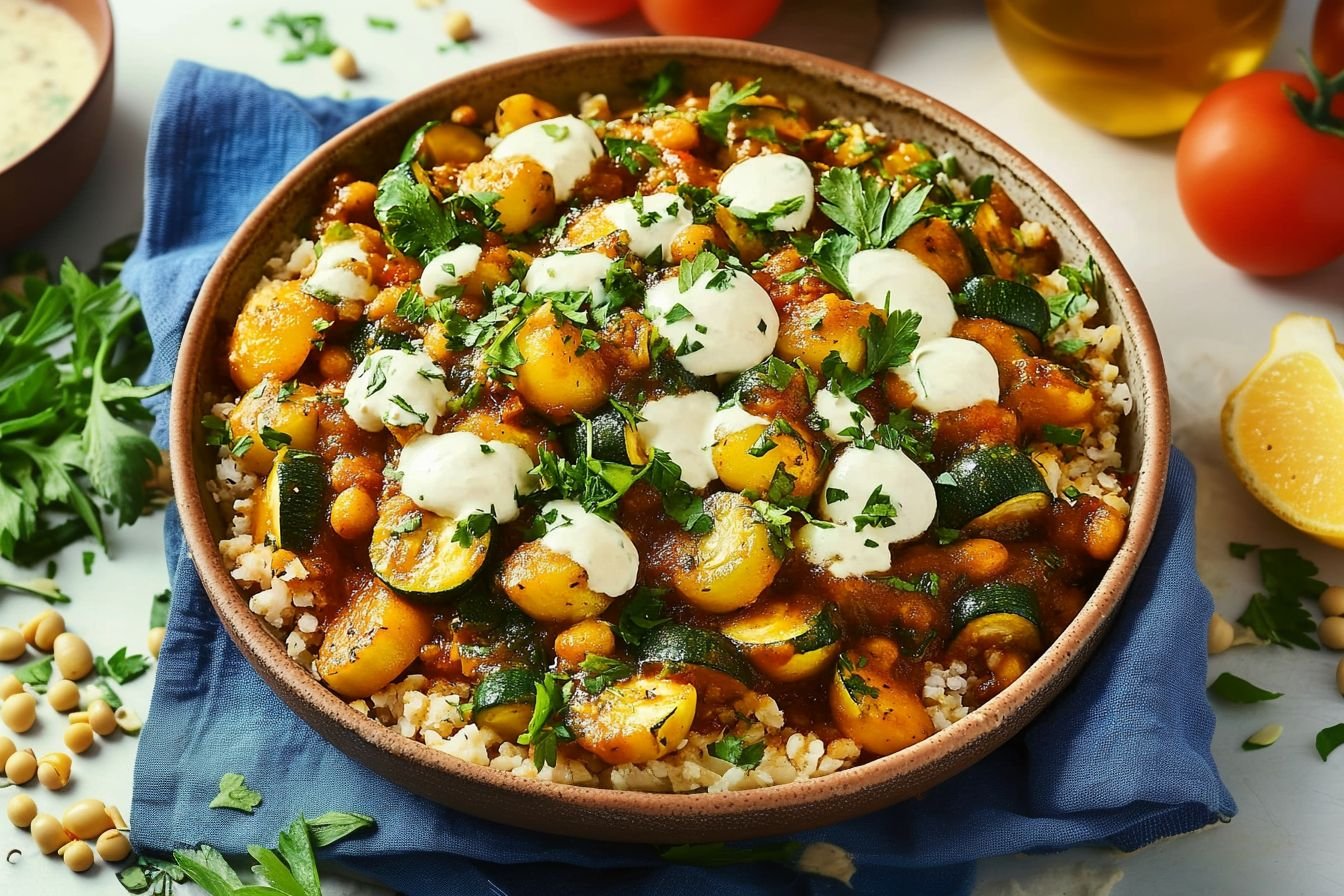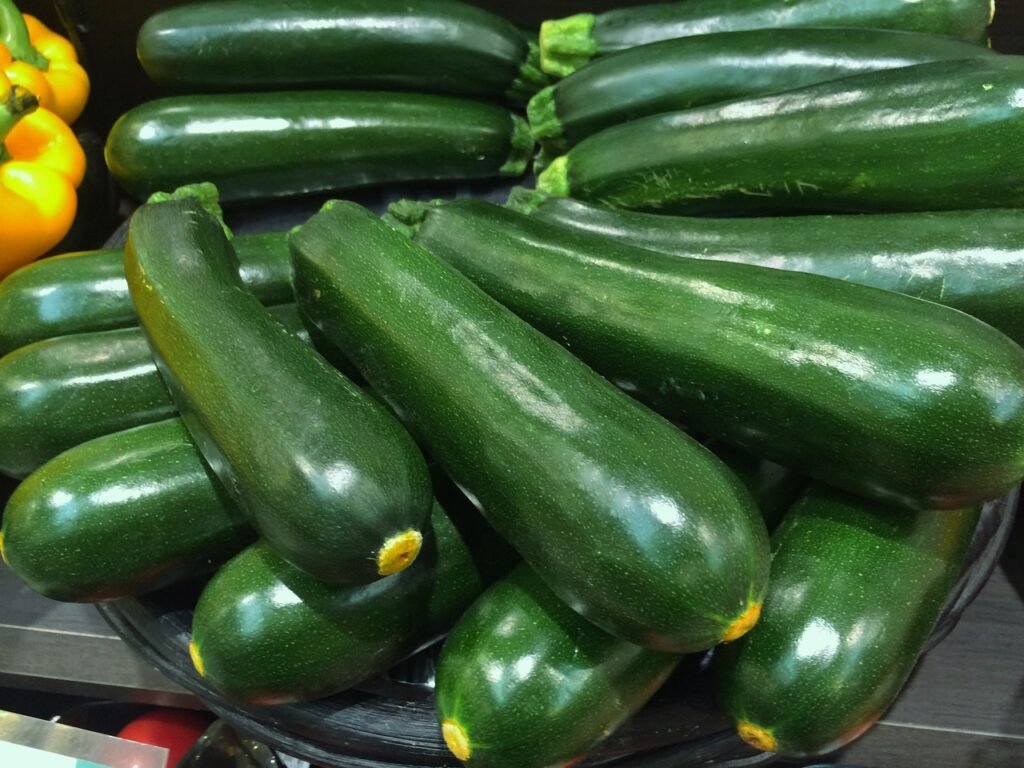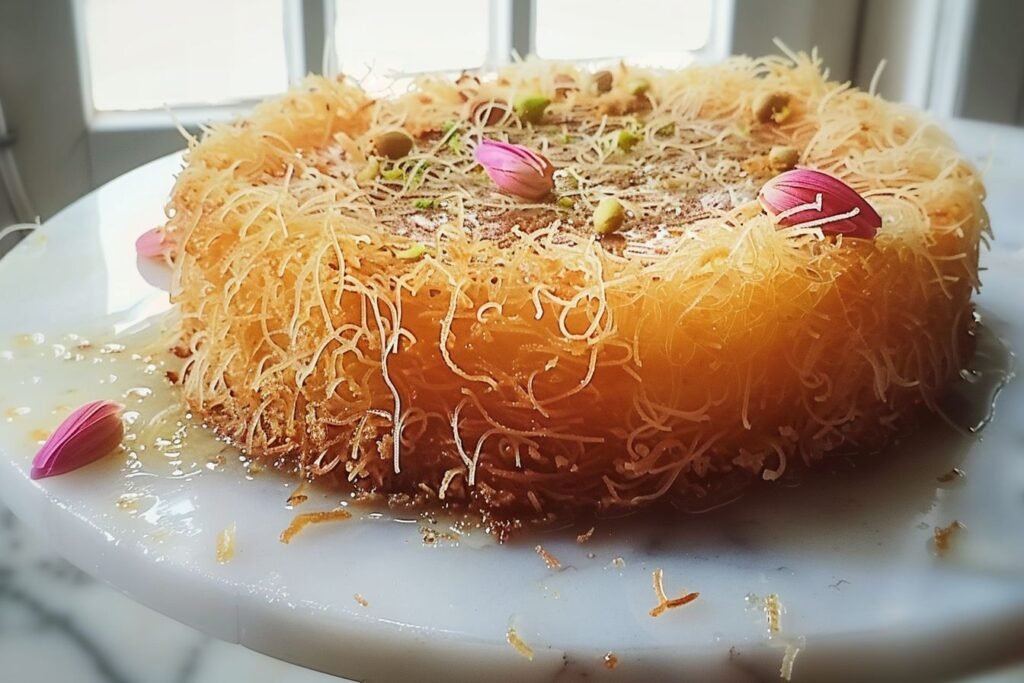Zucchini tagine is a great dish that brings the flavors of North Africa right to your kitchen. With just a few key ingredients like zucchini, yellow onion, garlic, cilantro, lemon, jalapeño, chickpeas, sour cream, veggie stock concentrate, couscous, Tunisian spice blend, almonds, dried apricots, and hot sauce, I can create a meal that’s both hearty and healthy.
What Is Vegetable Tagine?
Vegetable tagine is a traditional North African dish cooked in a tagine pot. This flavorful stew typically features a variety of vegetables, spices, and sometimes legumes.
The ingredients often include:
- Zucchini
- Carrots
- Chickpeas
- Onions
The dish is known for its aromatic spices such as cumin, coriander, and cinnamon. The unique cooking method helps the vegetables retain their flavors and nutrients.
I enjoy how versatile vegetable tagine can be. You can mix and match vegetables based on what’s in season or what you have on hand.
The cooking process involves slow simmering, which allows the flavors of the spices and veggies to meld beautifully. Serving it with couscous or bread makes for a hearty and satisfying meal.
Vegetable tagine is delicious and healthy. It’s a fantastic way to incorporate more vegetables into my diet. I often find that it appeals to both vegetarians and those who enjoy meat, making it a crowd-pleaser.
Ingredients:
- 1 zucchini
- 1 yellow onion
- 2 cloves of garlic
- ¼ oz of cilantro
- 1 jalapeño
- 1 lemon
- 13.4 oz of chickpeas (1 can)
- 4 tbsp of sour cream
- 2 vegetable stock cubes
- ½ cup of couscous
- 1 tbsp of Tunisian spice blend
- ½ oz of sliced almonds
- 1 oz of dried and chopped apricots
- 1 tsp of hot sauce
- 3 tbsp of olive oil
- 2 tbsp of butter
- Salt and black pepper to taste
How to make Zucchini Tagine?
First, the vegetables are prepped. This involves washing and drying all produce, mincing cilantro, zesting and halving a lemon, and mincing a jalapeño (seeds removed for milder heat). An onion is halved, peeled, and diced. Zucchini is trimmed lengthwise and sliced into half-moons. Garlic is minced or grated, and chickpeas are drained and patted dry.
Two sauces are then prepared. The chermoula is a mixture of cilantro, olive oil, garlic, salt, pepper, lemon juice, and jalapeño (adjusted to taste). The lemon cream combines sour cream, salt, lemon zest, and water (added slowly for a drizzling consistency).
The couscous is cooked separately. Olive oil is heated in a small pot over medium-high heat. Onion is added and sautéed until softened, approximately 2-3 minutes. Water, half the stock, and a pinch of salt are stirred in and brought to a boil. The couscous is then added, and the heat is turned off.
The tagine itself is then prepared. Olive oil is heated in a large pan. Zucchini and the remaining onion are added and cooked until softened and lightly browned. Spices, garlic, and salt are added and cooked until fragrant. Water and the remaining stock are stirred in, followed by the chickpeas. The mixture simmers for a couple of minutes before the heat is lowered and the butter is mixed in.
The couscous is fluffed with a fork, and butter and seasoning are incorporated.
Finally, the dish is assembled. The tagine is served over couscous and garnished with almonds and apricots. The lemon cream and chermoula are drizzled over the top, and lemon wedges are added on the side.
Nutritional Information
| Nutrient | Amount per Serving |
|---|---|
| Calories | 930 |
| Protein | 23 g |
| Total Fat | 47 g |
| Saturated Fat | 14 g |
| Carbohydrates | 99 g |
| Cholesterol | 50 mg |
| Dietary Fiber | 15 g |
| Sugars | 20 g |
| Sodium | 780 mg |
Serving Suggestions for Zucchini Tagine
Accompaniments
To complement the rich flavors of this tagine, I often serve it with couscous or quinoa. Both options absorb the tagine’s sauce beautifully, offering a delightful texture contrast.
I also enjoy pairing it with warm pita bread or a crusty baguette for dipping. This adds a nice crunch.
Consider adding a side of roasted vegetables to provide a colorful contrast on the plate. Incorporating elements like chickpeas or toasted almonds can introduce protein and crunch, enhancing the overall experience.
Presentation Tips
A well-presented dish can elevate the meal. I like to serve it in a traditional tagine pot for authenticity, but any deep dish works.
Garnishing the tagine with fresh herbs like cilantro or parsley not only adds color but also brightens the flavors.
I often sprinkle some lemon zest or drizzle a bit of extra virgin olive oil over the top as a finishing touch. This adds a burst of freshness and makes the dish visually appealing.
For a pop of color, I recommend serving it with sliced olives or cherry tomatoes on the side. This not only enhances the look but adds variety to each bite.
Storing and Reheating
Storing
- Refrigerator: Transfer the dish to an airtight container. It can last for up to 3-4 days in the fridge.
- Freezer: For longer storage, freeze it in a freezer-safe container. It can be stored for up to 3 months.
When freezing, I like to portion it out for easy reheating.
Reheating
To reheat, I have a few options:
- Microwave: Microwave in a covered dish. Heat in 30-second intervals, stirring in between. This keeps it moist.
- Stovetop: Heat in a pan over medium-low heat. Stir often. Add a splash of water if it seems dry.
- Oven: Preheat the oven to 350°F (175°C). Cover with foil and heat for about 15-20 minutes.
Tips for Perfecting Your Tagine Skills
- Choose the Right Ingredients: I always select fresh vegetables and high-quality spices. This impacts flavors significantly.
- Control the Heat: I’ve learned that cooking on low heat is key. This allows for even cooking and rich flavor development.
- Use the Lid Properly: Keeping the lid on traps steam, ensuring my dish remains moist. I avoid lifting it too often to maintain heat.
- Experiment with Spices: I enjoy trying different combinations of spices like cumin, coriander, and paprika. Each adds a unique taste.
- Don’t Overcrowd: I make sure not to overcrowd the tagine. This way, everything cooks evenly.
- Let It Rest: After cooking, I let the dish sit for a few minutes. This allows the flavors to meld perfectly.
- Serve with Accompaniments: I love serving tagine with couscous or bread. They complement the dish wonderfully and soak up the sauce.
Conclusion
Zucchini tagine offers a delightful experience for anyone who enjoys flavorful vegetarian cuisine. I appreciate how versatile this dish can be, allowing for endless variations of spices and ingredients.
I love the combination of fresh zucchini, tender vegetables, and aromatic spices simmered together. It not only satisfies my taste buds but also fills my kitchen with inviting aromas.
It’s a perfect dish for a cozy meal or entertaining friends. The vibrant flavors and textures create a memorable dining experience that I always look forward to.
By the way, kunafa with saffron is a perfect dessert for this dish!
Get the recipe now (by clicking the image below):






